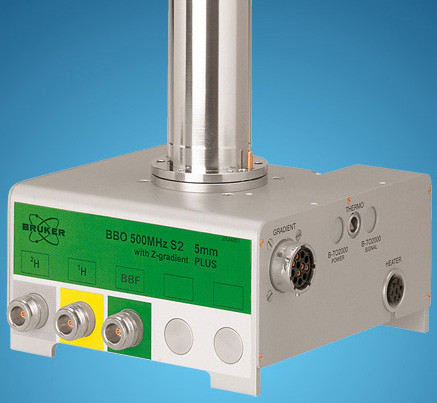Broadband Probe
One type of a probe, which will be described here as an example, is the 5 mm BBO Smart probe. As its name suggests this probe is designed for users who are interested in analyzing samples of various nuclei. The x-frequency range is typically from 15N to 31P including 19F.
The left BNC is marked 2H (see figure below) and is used to carry the lock signal. The other two connections are for the 1H and x-nucleus signals and are labeled accordingly. The cables leaving the 1H, X and 2H BNCs are connected to the preamplifiers.
Example of a Broadband Probe
The probes are designed to enable the temperature of the NMR sample to be controlled. A heater is used in conjunction with an air/N2 transfer line to control the sample temperature. A thermocouple serves as a thermometer to monitor the sample temperature. All these devices are attached to the base of the probe and are easily accessible. The Variable Temperature Unit (VTU) which is located inside the console constantly monitors the thermocouple reading and makes adjustments in the heater power to maintain the required temperature.
All but a few high resolution probes come equipped with gradient coils and the connector is found on the side of the probe base.
Finally, the black box on the underside of the probe base houses the tuning and matching equipment. These are used to make fine adjustments to the probe in order to optimize the performance. When a compound is analyzed it is excited with signals of a definite frequency (the resonance frequency). Different nuclei will be excited by different frequencies and tuning involves adjusting circuitry within the probe so that it is at its most sensitive for the frequency of interest. The probe is also matched to ensure that as little as possible of the excitation signals and the FID are reflected (i.e. wasted). Both tuning and matching are interactive in that they cannot be adjusted independently of each other.
The probe should be tuned and matched every time the sample in the magnet is changed. Each coil in the probe is tuned and matched separately using the ’atma’ or ’atmm’ routine which is described in Tuning and Matching the Probe.
Changing a probe will require reconnecting the probe to the preamplifiers.


